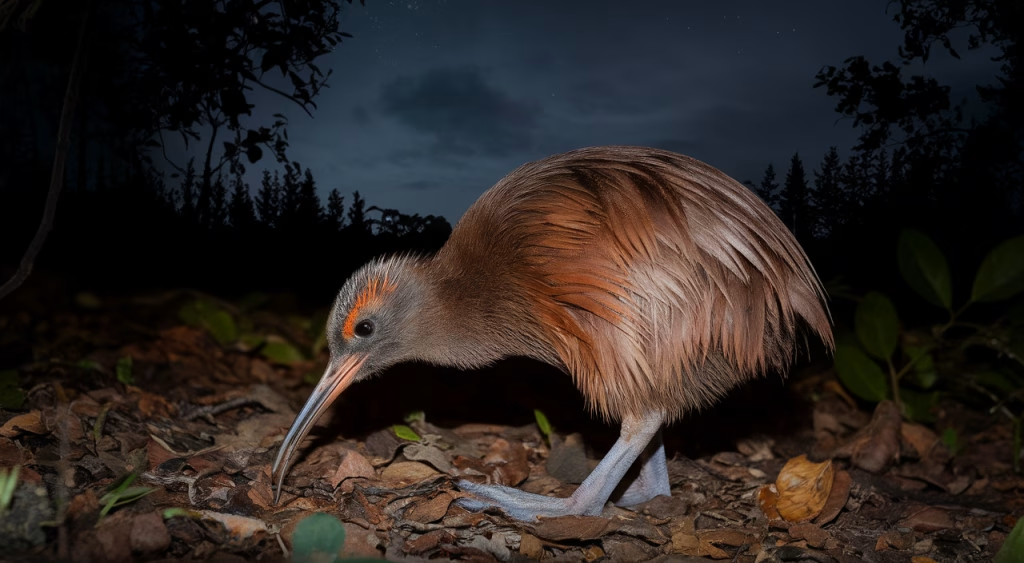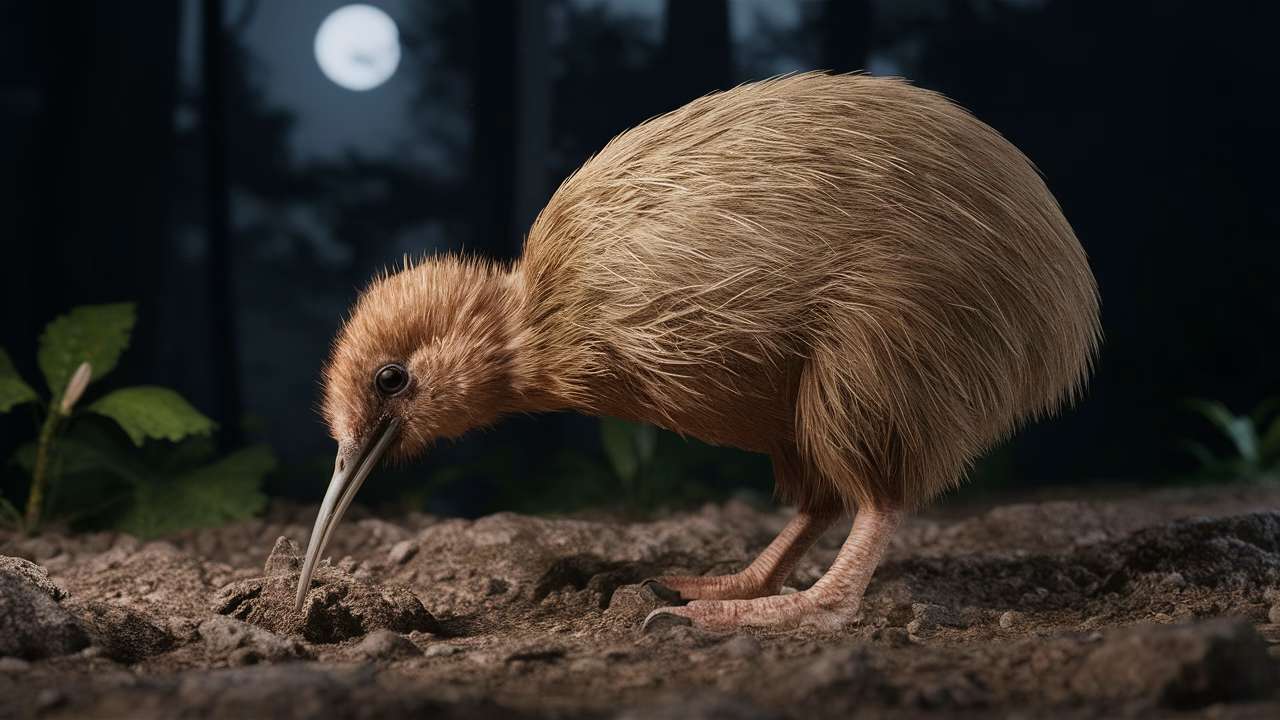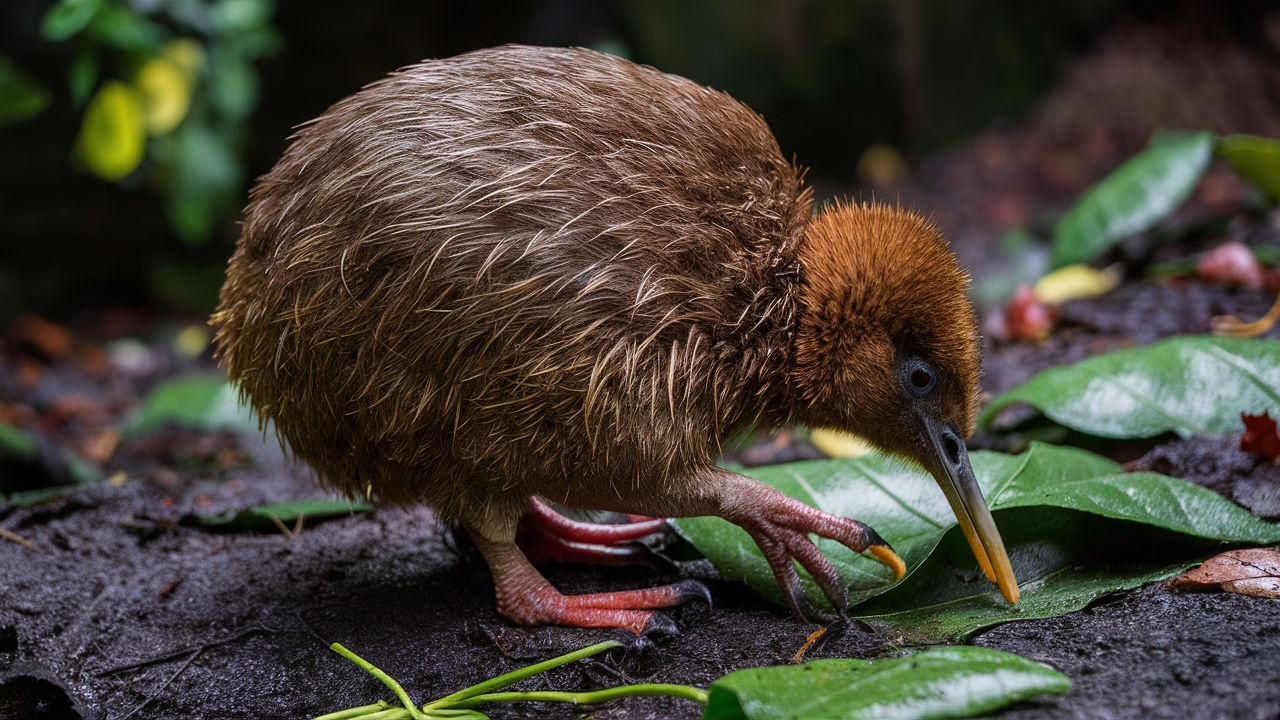Why do kiwis have nostrils at the tip of their beak?
Kiwi nostrils are uniquely located at the very tip of their beak—an extraordinary adaptation that sets these New Zealand birds apart from virtually all other avian species. This strategic nostril placement allows kiwis to excel at insect hunting by literally sniffing out their prey beneath the forest floor, compensating for their notably poor eyesight in these nocturnal hunters.
TL;DR – Kiwi Nostrils: A Groundbreaking Adaptation
- Unique among birds: Kiwis are rare in having nostrils at the tip of their beaks, unlike most birds with nostrils near their eyes.
- Enhances foraging: This adaptation allows kiwis to detect prey underground, particularly insects and larvae hidden in soil or leaf litter.
- Evolutionary insight: Kiwi nostrils evolved alongside other key traits: nocturnal behavior, poor eyesight, and a long, slender beak.
- One-of-a-kind avian hunter: The entire kiwi anatomy is honed for terrestrial insect hunting, making it one of the most unique bird species on Earth.
The Unique Adaptations of Kiwi Nostrils
How Kiwis Use Their Nostrils to Hunt
Picture yourself walking through a dense New Zealand forest at night, hearing gentle rustling at your feet. That’s likely a kiwi engaged in its specialized insect hunting technique, with its beak buried deep in the soil. Unlike other birds that rely on sharp vision, kiwi nostrils positioned at the beak’s tip allow these remarkable hunters to “smell” their food underground—a behavior practically unheard of among unique bird species.
While most birds depend on keen eyesight or tactile vibrations through their beaks, kiwis have mastered olfactory-based insect hunting. In the rich, earthy environment of New Zealand’s forests, they can detect the subtle chemical signatures of worms, insects, and grubs hiding beneath layers of moss and decomposing leaves. This sensory adaptation rivals the sophistication of echolocation in bats or electroreception in sharks.
Evolutionary History of Kiwi Nostril Placement
Understanding this remarkable feature requires examining how kiwi ancestors adapted to ground-based, nocturnal lifestyles. Fossil evidence and comparative anatomy reveal that the evolution of kiwi beak structure favored enhanced olfaction over visual hunting capabilities. Over millions of years, the beak bones evolved—becoming elongated and specialized to accommodate both complex nerve networks and optimized airways for their unique nostrils.
Remarkably, while kiwis belong to the ratite group of flightless birds (including ostriches and emus), none of their relatives possess such forward-positioned nostrils. This specialized adaptation evolved specifically for New Zealand’s dense, historically predator-free forests, where nighttime scent-based hunting proved far more effective than visual scanning for insect hunting.
The Role of Kiwi Beak Structure in Insect Hunting
Anatomy of a Kiwi Beak
The intricate kiwi beak structure represents evolutionary perfection for underground foraging. Long, slender, and elegantly curved, this specialized tool excels at probing leaf litter and penetrating soft forest soil. But this beak is far more than a simple probe—it’s a sophisticated sensory organ housing an intricate network of nerve endings, blood vessels, and specialized Herbst corpuscles that detect the slightest underground movements of burrowing insects.
What makes this beak structure so remarkable? While parrots crack nuts and hummingbirds sip nectar, kiwis have evolved their beaks as scent-guided precision instruments. This extraordinary adaptation allows them to access protein-rich meals in the dark, damp conditions where traditional visual hunting would prove useless.
Behavioral Insights: How Kiwis Adapt to Their Environment
Observing wild kiwis reveals their methodical approach to insect hunting. These unique bird species move with deliberate purpose, pausing frequently to probe the forest floor with their specialized beaks. What appears to be listening is actually intensive sniffing—the bird precisely controlling depth and angle based on scent trails and moisture cues that indicate live prey below.
The kiwi’s adaptations extend beyond their remarkable nostrils. Their fur-like feathers provide camouflage, while oversized claws excel at scratching through forest debris. These features work harmoniously toward one goal: silent, efficient insect hunting. In New Zealand’s historically predator-free environment, kiwis never needed speed or flight for escape—instead, evolution refined their sensory capabilities and ground-level expertise.
How Do Kiwis Find Food Underground?
Kiwis tap into an invisible world of scent that most animals miss entirely. Earthworms release detectable pheromones, while grubs emit gases like CO2 as they break down organic matter. Through their tip-positioned nostrils, kiwis can detect these faint chemical signatures even beneath several centimeters of forest mulch. This sophisticated insect hunting ability allows them to discover prey that other predators completely overlook, making them incredibly efficient foragers in New Zealand’s cool, damp forest environments.
| Trait | Kiwi | Typical Bird |
|---|---|---|
| Nostril Placement | Tip of beak | Base of beak |
| Primary Hunting Sense | Smell + Touch | Vision |
| Beak Type | Long, thin, sensitive | Varies, often stronger or shorter |
Evolution of Kiwi Beak Structure
The remarkable evolution of kiwi beak structure tells a fascinating story of environmental adaptation. As New Zealand’s ecosystems developed, competition for visible insects intensified among various species. However, kiwi ancestors discovered an untapped ecological niche underground—a food source few other birds could access. Natural selection strongly favored individuals with longer, more sensitive beaks and increasingly sophisticated nostril placement for effective insect hunting.
What emerged from this evolutionary process is a bird so specialized for ground-based living that it barely resembles typical avian species. These unique bird species represent a remarkable biological fusion—part bird, part underground specialist, thriving in New Zealand’s distinctive forest environments through scent-based navigation rather than visual hunting.
Surprising Facts About New Zealand Wildlife
New Zealand functions as nature’s evolutionary laboratory, producing not just kiwis but also flightless parrots (kakapo), intelligent alpine parrots (kea), and bioluminescent wetas. Why does this island nation harbor so many unique bird species? For millions of years, New Zealand remained free of land-based mammalian predators, allowing birds to evolve freely into ground-dwelling, nocturnal specialists without fear of traditional threats.
While the kiwi serves as New Zealand’s iconic symbol, every forest corner shelters specialized creatures shaped by evolutionary isolation. When you consider this extraordinary biological diversity, the strategic placement of kiwi nostrils becomes a crucial piece of a much larger evolutionary puzzle that makes New Zealand wildlife truly remarkable.
Final Thought
The positioning of kiwi nostrils may seem like a minor anatomical detail, but this single adaptation defines everything about these remarkable birds—their hunting strategy, evolutionary success, and ecological role. It’s a powerful reminder that in nature’s grand design, even the most subtle feature can determine the difference between extinction and thriving as one of the world’s most unique bird species.
Frequently Asked Questions
Why do kiwi birds have nostrils at the tip of their beak?
This unique trait helps kiwis detect prey underground using smell, a rare feature among birds.
How do kiwis hunt insects in the dark?
Kiwis rely on their keen sense of smell and tactile receptors in their beak, rather than sight.
Are kiwi birds completely blind?
No, but kiwis have very poor eyesight. Their nocturnal lives rely more on smell and touch.
What makes the kiwi different from other birds?
Aside from their ground-based lifestyle, kiwis are unique in beak structure, nostril placement, and sensory hunting ability.
Do other birds use scent like kiwis?
Almost none. Most birds rely on vision. Kiwi olfaction is an exceptional case in avian biology.
Where can I see kiwis in the wild?
Remote native forests in New Zealand, especially on predator-controlled islands or reserves.
Why are kiwis considered endangered?
Habitat loss and predation by mammals introduced to New Zealand threaten their survival.





